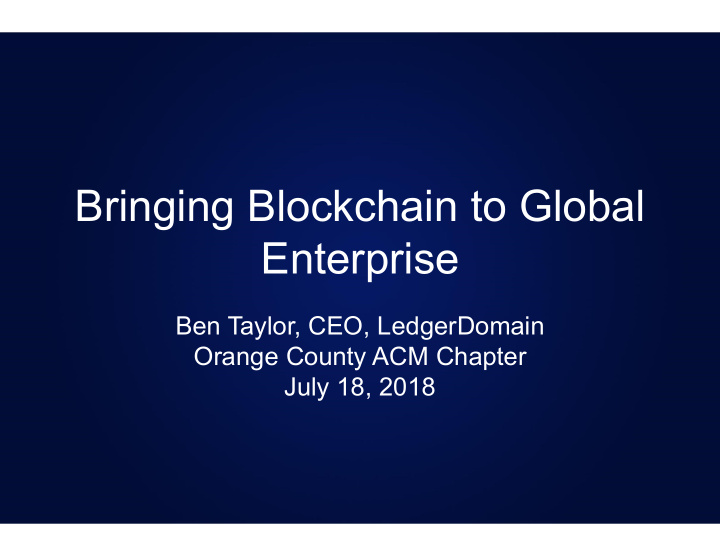



Bringing Blockchain to Global Enterprise Ben Taylor, CEO, LedgerDomain Orange County ACM Chapter July 18, 2018
Blockchain: Hyped and Ridiculed
How Bitcoins Get Transferred
So What Have We Learned from Bitcoin? • Human progress is anchoring through STIPULATION of an ASSUMPTION • Bitcoin’s stipulation is that the tallest block is the right block • 10 million members agree on a single version of the truth every 10 minutes • Most corporations haven’t had a single version of the truth since 1987
8,000 Years of Accounting History Blockchain is the latest in a long line of financial computing innovations Pacioli’s Summa (1494) • Double-entry bookkeeping MIT Whirlwind (1951) Incan Khipu • Parallelized logic Decimalized computer • Magnetic core memory Permanent storage • Real-time graphical output 1st distributed database
8,000 Years of Accounting History Blockchain enables multiple parties to jointly transact & settle in near real-time Joint My Your Execution Planning Planning Agreed Settlement
What is Blockchain / Distributed Ledger? “ We’ve always looked for a distributed database with a trust harness that allows multiple organizations to collaborate... Clearly, the blockchain and the distributed ledger that exists underneath it is a very novel implementation which can have massive implications.” – Microsoft CEO Satya Nadella
What is Blockchain / Distributed Ledger? Blockchain: data structure capturing events are immutably time-stamped Events : when parties agree to mutually e- sign a transaction in accordance with a “smart contract.” Once notarized into a blockchain, the commitment is binding and irrevocable. Records in the blockchain are encrypted and linked, making alterations almost impossible. A series of smart contracts from Satoshi Nakamoto’s original paper. Every bitcoin user has a public and private key – one for receiving, and one for sending. When a transaction is made, it The associated ledger is a consensus of is broadcasted to all the other nodes on the blockchain and verified. Once completed, the record of the transaction is replicated, shared, and synchronized digital virtually impossible to modify. data across multiple participants.
Distributed Ledger Variants Important distinctions amongst different blockchain platforms • private vs. public blockchains (commingled data)? • open or by invitation membership (permissioned access)? • network costs borne by subscription or bounties (mining)? Bounties are typically paid in the form of cryptocurrency to successful “miners” with newly minted coins, thereby adding inflation to system • Permissioned blockchains may be warranted when access to information needs to be restricted based on necessity and privacy laws. • On-chain vs. off-chain? Which data elements to store on the blockchain vs. store remotely? Cash register tape & stock ticker are blockchain precursors.
Comparing Blockchain Platforms Positioning Visionary Enterprise-grade Classic Governance Ethereum Foundation? Linux Foundation Hmmmm Participation Open with Velvet Ropes Permissioned, private Open Consensus PoW PoS? Pluggable consensus PoW Mining Smart contracts Yes, typically Solidity Yes, typically Go or Java More basic Currency ether, gas, altcoins None in native form bitcoin Partially sourced from SBC Working Paper, 6/2017
Enterprise Computing Situation Report Enterprises went hard into Relational Database in the ’80s • Client service and the web pushed the client points further and further • Application servers managed & personalized client experiences “Big data” is nice way of saying relational has failed Wall Street: Algorithms (smart contracting) & High-frequency (real time) Amazon and Google raised expectations…. Enterprises: feet in relational concrete and heads in the big data clouds?
Challengers in Enterprise Blockchain Development Linux Foundation and IBM driving Hyperledger Fabric Amazon Web Services, IBM, HP, Microsoft, Oracle, and SAP styling themselves as blockchain-as-a-service (BaaS) providers Financial services companies have formed consortia while pioneers like Northern Trust are in production with blockchain internally Ethereum enterprise edition under way, while JPMorgan has launched Quorum initiative off Ethereum Standalone proprietary blockchains such as Ripple have emerged
How Can Enterprises Move Incrementally? Blockchain Attributes Strengths Weaknesses Opportunities Threats 1. Shared data model Key partnership Hard to change Future-proof 2. Shared client and data model Site efficiency Maintainability Viral Infection 3. Shared open system TCO Platform control Lightning? Security model 4. Shared permissioned system Industry control Less flexible Upgradability 5. Shared permissioned and Gold standard Expensive Upgradability partitioned system
Blockchain Solution Process Flow
Enterprise Use Cases for Blockchain Global supply chains: pharmaceuticals, electronics, national security procurement, etc. The blockchain-based supply chain opportunity for discrete finished products will exceed $424 million globally by 2023 (ABI Research). Private transactions between banks: Currently while a million wires shoot back and forth between two banks in the course of a day, the money itself moves only in single massive net transfers (e.g. the SWIFT system). Patient records: Encrypted patient records would allow for real-time access with greater security.
LedgerDomain Simplified Architecture
Where is Development Heading? • Chaincode portability, blockchain federation and integrability • More robust models for organizations and permissions • Analytics on chaincode data • Next-generation crypto and data models • Integration with enterprise systems such as ERP & MES • Designing for compliance with privacy laws (e.g. HIPAA, GDPR) Blockchain, artificial intelligence & IoT combine to make every transaction …instantaneous, confidential, unforgeable & trackable
Feedback and Questions?
Where to Learn More How Blockchain Unlocks the Fourth Wave of Financial Computing Hyperledger Fabric
Recommend
More recommend